by Mandy Page

Hot sun, blue tiles, a whisper of a breeze and the faint smell of camel – all this means I have to be on a street in Bukhara. The main avenue is now sealed but it still passes the massive doors of a caravanserai. Inside the courtyard remains untouched; if you wanted to you could park your camel for the night and disappear into the small cell-like rooms which face the central area. The small rooms are now artisan shops but really their use is not too far removed from the traders who drifted through Bukhara when animals carried merchandise instead of planes, trains and trucks.
Following the street from the tiled pool surrounded by ancient trees towards the market there are many vendors displaying their wares. These tempting goods range from pottery items, silk scarves to knives and scissors which Bukhara is known for. The street then enters the first of the covered markets. Inside the hot sun is replaced by domed archways and dusty light; shops spill onto the pavement. Carpets with rich reds, blues and greens mix with fur hats and colourful clothes. Against the walls are the rings for tying up camels, goats and slaves. Around the corner is the spice shop where the fragrances of mint, cardamom and cinnamon scent the air. I really like visiting the spice shop as they also sell tea which is rich in taste. They also sell

the bread markers; these markers let the locals know which family baked the bread which is sold daily in the market. The bread markers make a great and unique gift for people at home.
Another corner of the covered markets holds the money changer and the antiques. For centuries people have travelled along the Silk Road and left masses of stuff behind, and of course its available in the market. Each time I return there always seems to be plenty of antiques – so I am beginning to think there might be some ‘fresh’ antiques on the pile.
At the other end of the market the street opens out into an area of mosques and maddrassahs. The colourful towers still call the faithful to prayer. One of the largest of these carries the wounds of Napoleon’s cannon balls – the tower has been repaired but when the sunlight hits the surface you can see the repaired tiles.
 Along the street is also the male bath house. This institution has been active since the 16th century and you too can sit in the dark, steamy rooms and experience a real Turkish bath. I think the attendants are luckier than their predecessors (they are not eunuchs) and the tea-towel which keeps them decent covers more than a cell phone and extra cash.
Along the street is also the male bath house. This institution has been active since the 16th century and you too can sit in the dark, steamy rooms and experience a real Turkish bath. I think the attendants are luckier than their predecessors (they are not eunuchs) and the tea-towel which keeps them decent covers more than a cell phone and extra cash.
I love Bukhara for the glimpses of its colourful past, its acceptance of modern life and its unique blend of many races crossing roads in history.
Text box item sample content